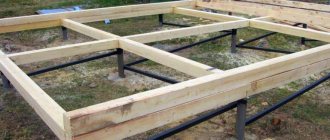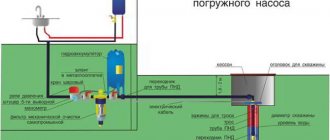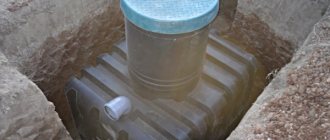The distance from the house to the well is an important parameter of SanPiN and SNiP (SP), compliance with which guarantees both the convenience of the user of the source of drinking water and its good condition. The lack of centralized water supply and sewerage makes it difficult to place a well with drinking water on a small area in accordance with all existing rules. It is better to determine the minimum distance from the well to the house on a plan prepared for approval by supervisory authorities, and begin construction after receiving approval.
At the dacha in the village
Consequences of incorrect placement
In drilling, the main thing is that the source shaft is located above the aquifer. It is necessary to choose a convenient location that provides access for the drilling machine.
Finding the aquifer is sometimes difficult. For better results, you should pay attention to some side factors:
- geological feature of the site;
- close proximity to surface water;
- typical plant species.
Sometimes it is worth doing exploratory drilling.
There are a number of other factors that must be taken into account when drilling. This is primarily protection from contamination. Incorrect location of the source can lead to runoff, industrial waste and landfills.
The minimum location from the septic tank is at least 30 m, and preferably 50 m. The distance from garbage heaps or industrial warehouses is 100 m or more.
Rotary wells for sewerage
This type of wells in its purpose and design is absolutely identical to inspection wells, with the only difference being that rotary wells are installed in places where the direction of the pipeline changes. Sharp bends with large turning angles are usually the areas most likely to become clogged and require special attention. This is precisely the function that rotary wells perform.
The distance between rotary sewer wells is usually calculated based on the length of the straight sections between the bends of the pipeline. If the pipeline section is longer than specified by the regulatory document, then it must be equipped with inspection wells in order to ensure a sufficient level of control over the operation of the system.
Rules and regulations
They are regulated by a number of regulatory documents. Namely:
- The rules for the location of external water supply networks are regulated by SNiP 02.04.02-84.
- The rules for the arrangement of sewer networks are established by SNiP 02.04.01-85. The requirements for the sanitary protection zone are also regulated here.
According to these SNiP standards, the following recommendations should be taken into account:
- the source should be located in environmentally friendly coal of the site;
- the recommended distance from the septic tank to the well is 50 m;
- it is necessary to drill above the location of the sump;
- the septic tank is installed 5 m from the residential building and the edge of the road;
- the cesspool is dug at a distance of 4-5 m from neighboring areas.
Choosing placement and determining depth
When building a well, you need to determine its expected depth and number of rings. If the site is new and construction has not yet begun, the search for water should begin by examining the sources used by the neighbors.
How to find the right location for a well
To find it, you need to know the following information:
- The depth of wells and wells in neighboring areas;
- Volumes of water loss;
- Terms of use;
- Features of operation.
If there are no neighbors, the task becomes more complicated. Then it is recommended to use one of the methods for determining the water source. The most popular of them:
- Dowsing;
- Hydrogeological indications;
- Local manifestations of water.
None of them will give a 100% guarantee of data accuracy. However, you should know that it can be carried out at a certain distance from water supplies in neighboring areas. Otherwise, the water from them may simply go into newly formed wells. In addition, this method is quite expensive and is more suitable for undeveloped areas.
Find out how to make a well house with your own hands.
See photos of crafts made from tires for the playground.
Video of fish breeding in a home pond: .
Criteria for choosing a site on the site
Careful selection of location is a prerequisite for creating a reliable and high-quality source of water supply. This approach will eliminate the risk of receiving water that does not meet sanitary standards. When choosing a location, they are guided by the following criteria:
- Convenient location on the site;
- Distance between wells and objects of use;
- Distance from sources of pollution.
Distance from the house, septic tank, cesspool and neighbors’ fence
The footage from the well to the house does not have a clearly defined value. There are cases when the water source is located directly in the basement of a residential building. The only criteria in this matter are the ability to conveniently access the drilling machine site and not damage the foundation in the event of an accident.
The presence of various communications is taken into account, such as water supply, gas pipelines and electric cables. The mine should be located at least 30 meters from the low-pressure gas pipeline, and 100 m from the high-pressure gas pipeline.
Where to place the well on the site in relation to the septic tank
Depends on the type of soil on it. If the soil is normal, there should be at least 20 m between them.
In conditions of sandy, sandy loam or loamy soil, the source should be located 50-80 meters from the septic tank.
When placing a septic tank or pit on a site, they take into account such an indicator as the hydraulic connection of the aquifer where the well is located and the soil where wastewater can get.
If there is no hydraulic connection and wastewater does not flow directly into the aquifer, the gap can be as short as 20 meters. If the aquifer is not protected, it is increased to 50 meters.
Water quality can be affected by the proximity of a septic tank. It must be removed from the source by at least 30 meters.
Advice: the well should be located above the level of the cesspool to prevent wastewater from entering it, which can lead to contamination of drinking water.
It is also worth considering the question of what distance from the well the well should be located. Although it acts as a source, it can cause pollution due to its design.
What you need to know about the distance of the well to the foundation
The problem of the location of a well on a site is especially relevant for owners of small plots. The structure should be as convenient as possible. To do this, it is positioned so that it is possible to easily organize the supply of water to buildings on the site, such as a house or a bathhouse, as well as to a vegetable garden. Usually, the highest place on the site is chosen for the well; it should not be allowed that the cesspools of neighbors are located higher in the terrain.
Find out what a pumping station for a well is here.
In addition, the impact of the mine on the neighboring building should be taken into account. For a well, choose a place closer to the house. This is due to the peculiarities of organizing water supply: supplying water to a house over long distances is an expensive pleasure. Wells can even be built inside a house. Usually, they first build a shaft for the well, and then dig a pit for the foundation. In this case, the type of soil and topographic conditions of the site should be taken into account.
It’s another matter when the house is already ready, but the well is only in the plans. Houses on shallow foundations may suffer from the proximity of well shafts. You should not install wells in close proximity to such buildings. Shallow strip foundations on clay are especially dangerous in this regard. Here it is worth considering the depth of the well. Shallow mines are more troublesome for buildings. Water can wash away the foundation.
You may also be interested in information about decorative covers for wells.
Wells can be located at a distance of at least 3 m from the foundations of buildings. This norm is prescribed in SNiP 30-02-97.
The minimum distance to buildings for keeping animals is 4 m, other buildings – 1 m, trees – 4 m, bushes – 1 m.
Responsibility for non-compliance with SNiP and rules
The construction of wells in a suburban area must, along with construction standards, also comply with legislative sanitary rules - SanPiN. This is especially true for cesspools, which require some care.
Any type of septic tank or waste pit must be cleaned twice a year with a sterilizing mixture. This is done after pumping out with a sewer truck. A special solution is used, which contains acid and gentle compounds.
Violation of sanitary rules is subject to a fine and, in some cases, a court order to remove the septic tank from the site.
Sewage system in a private house
The water intake system, as well as sewerage, in a city apartment or autonomous building (a house in the private sector, for example) varies. The difficulty of draining sewerage in an apartment lies in the correct installation of pipes (with a slope towards the riser). It is also not difficult to install a water supply system; you just need to wire it to the planned points and connect to a centralized water supply system.
Private houses differ significantly in communications from apartments and from each other.
The differences are as follows:
- source of water supply: water supply, borehole, well;
- the method of drainage of sewage can be internal or external;
- length of communication systems.
The drainage system of a private house is a painful issue, so its solution depends on the location of the building and the availability of access to the cesspool. If it is not possible to pump out sewage using special equipment, it is considered optimal to use a septic tank, which purifies the waste using a biological method.
Well in the basement. Is it possible?
It is possible to place a well in the house, but it is very undesirable. This has a huge number of disadvantages. Most likely the source will be artesian, and the depth of the well will be from 70 to 90 meters. Therefore, in the event of a breakdown, removing the equipment becomes difficult or it will not be possible to complete this task at all. If you need to flush the well, then this will not work either, because such a process is associated with a large volume of water that will rise from the well. And this is still a small part of the disadvantages associated with such an arrangement.
What standards must be followed?
The main document regulating the procedure for placing construction projects or communications is SNiP. It defines all permissible distances, conditions, and rules for creating a sewer system. In particular, the permissible gaps between the sewerage system and the nearest supporting structures are indicated in Table 14 of SNiP 2.
07.01-89. Standards for clearances between the system and power line supports, roads, ditches or other objects are also given here.
It must be taken into account that there are several documents regulating and defining the configuration of sewer systems. They do not contradict each other, but consider different aspects of construction - some specialize in design, others in the actual construction or selection of materials. According to current regulations, the distance from the sewer well to the foundation of the building is determined based on the type of sewerage:
- for pressure systems - at least 5 m;
- on gravity lines - 3 m.
The reference points are the gap between the edge of the foundation and the nearest wall of the sewer pipe. The maximum value from the base of the house to the nearest sewer of any type is 12 m, which allows for effective cleaning and inspection. If a tray with a large number of pipelines is used, the calculation is carried out along the edge of the trench. This is an important point, since the dimensions of some pipelines are quite large and can cause significant confusion when drawing up a project. In addition, it is important to ensure a minimum distance between sewer wells and the base of the house, outbuildings or auxiliary buildings. The recess under the well is usually larger than the trench for pipelines, and the distance from the walls to the foundation will be less. Usually, when drawing up a diagram, the placement points of the elements are first marked, observing the distance between the sewer inspection wells and the supporting structure of the nearest buildings. After this, the lines for passing trenches and other elements are marked. There are specific standards for septic tanks or other reservoirs.
[my_custom_ad_shortcode6]
Septic tanks - operating principle and design
Septic tanks are low-capacity wastewater treatment facilities. The main function of a septic tank is to process sewage and waste liquids and transform them into purified, clear and harmless water. There are different types of septic tanks. They differ in power, performance, and methods of water purification.
A septic tank for wastewater treatment is a structure for the mechanical treatment of wastewater by settling with anaerobic digestion of its sludge. (GOST 25150−82, article 44)
Septic tanks are sealed, all accumulations remain inside and, with the help of bacteria, are processed, liquefied and discharged into the drainage system. If the septic tank is in good working order, its contents do not in any way affect the drinking water of wells and boreholes.
Distance standards according to SNiP
The main document regulating the distances between communications is SNiP. However, the corresponding instructions are also available in SanPiN. If, when creating a project, inconsistencies between the requirements are discovered, one must be guided by sanitary regulations. This must be kept in mind, since some inconsistencies sometimes occur.
Horizontal distances between pipelines:
- between parallel sewer lines - 0.4 m;
- from sewer pipes to plastic water supply - 1.5 m, if a pressure system is used - 3 m;
- between cast iron pipelines with a diameter of more than 200 mm and the sewerage system - 3 m. If the water supply channels are smaller - 1.5 m;
- in the area where various communications are introduced, the distance between the water supply and sewerage risers must be at least 1 m.
Currently, metal pipes are rarely used, since they are significantly inferior to plastic products in price, ease of installation and efficiency. However, it is necessary to know the standards, since during construction there may be communications already in use.
Healthy
Often during the construction of communications it is necessary to cross the water supply and sewerage systems. In such situations, the distance between the pipes at the nearest point is measured not vertically, but in the light, i.e. in a straight line. In addition, there is a SNiP requirement that requires sewer networks to be located at a lower level than the water supply. This is due to two reasons:
- if the sewer breaks, wastewater will be absorbed into the ground, which will create a danger for communications located below the level;
- the need for repairs more often arises for water supply networks.
If, due to installation conditions, it is not possible to provide the required vertical distance, then the water pipe is placed in a case - a protective metal shell. Its length must correspond to the size of the intersection security zone - 5 m in both directions. In addition, the case is used if the distance between the water supply inlet and the sewer outlet is less than 1.5 m. This happens if the entry into the house is made through the wall of the bathroom, and its width does not allow the necessary network parameters to be provided.
There are also requirements for internal areas. For example, the distance between the sewer bed and the heating should not be less than 8 cm at the intersection point. This is done to ensure that the hot pipes of the heating unit do not deform the plastic of the lounger. If such a danger arises, an insulating gasket should be placed in the gap.
Location of the sewerage system in relation to the foundation
The distance from the sewer networks to the base of the building is indicated at the stage of creating the engineering lines project. Following the rules and regulations allows you to ensure safety for the residents of the house and the operation of all systems without breakdowns.
Minimum distance of various utility networks from the foundation of the house:
- pressure sewer – 500 cm;
- drainage – 300 cm;
- water supply – 500 cm;
- gravity sewerage – 300 cm;
- drainage line – 300 cm.
It is also necessary to take into account that wells for sewerage and water supply have a large diameter. The distance is taken from the base to the nearest well wall, and not to the center of the structure.
Drop wells
Installing sewerage in an area with difficult terrain is quite a troublesome task.
If the area has a noticeable slope, then the slope of the pipeline will also be appropriate, which is absolutely not allowed: wastewater moving at high speed will gradually settle on the walls of the sewer system, thereby clogging it and rendering it unusable. Regulatory documents in this case speak of the need to install differential wells, which are installed in stages and compensate for the high speed of waste transportation, saving the structure from blockages (more details: “Difference sewer wells are an important necessity”).
SNiP does not determine the specific distance between sewer wells in this case, but imposes some requirements on the design:
- firstly, the height of one drop should be less than three meters;
- secondly, with differences up to 0.5 m deep (when using pipes with a diameter of up to 600 mm), differential wells can be replaced with inspection wells using drains.
You should always remember that any sewer system ends at a spillway point, at which there is necessarily a final well, which requires an inspection hatch.
Video review:
Everything useful about sewerage - gidkanal.ru GidKanal | Yandex Zen
Communication systems are a mandatory attribute of every living space. The successful functioning of engineering communications is laid down at the design stage, and ignorance of the specifics of the relative position of individual systems or their components can lead to troubles, even to catastrophic consequences.
The content of the article:
Photo for the article.
[my_custom_ad_shortcode5]
Choosing a place to drill a water source
The presence of an aquifer on the site and its location are fundamental factors that determine the depth and technology of drilling a well, the method of its construction and the need to use filtering equipment. To create a safe and productive autonomous water source, preliminary exploration work is carried out by test drilling, the purpose of which is to study the hydrological features of the site, search for the aquifer and establish its qualitative and quantitative characteristics. There are:
Initially, test drilling is carried out to study the hydrological features of the site and search for the aquifer.
- The first aquifer, closest to the surface (up to 7 m), is called perched water. It is formed due to seepage into the soil and seasonal accumulation of precipitation. Such water is characterized by a high content of pollutants and harmful impurities, and therefore is not suitable for consumption by humans and animals. It can only be used as a technical liquid (for irrigating the soil, cleaning the local area, mixing mortars, etc.).
- Gravity groundwater, lying between impermeable layers at a depth of 10-20 m, has higher characteristics and can be used for drinking, provided that sanitary requirements are met and filtration systems are installed. The quality of water will depend on the geological features of the site, because... layers may differ in structure and water permeability. In private farms, wells are most often developed to reach interstratal waters.
- Artesian waters, located at depths from 40 to 110 m, are of the highest quality. Due to the labor-intensive and high cost of work on tapping the aquifer, as well as the need to obtain official permission to carry it out, not many owners of suburban areas can afford to acquire a personal artesian well.
When choosing a location for constructing a deep water source, you should take into account the location of residential and commercial buildings and landscape features in order to ensure free passage and placement of heavy equipment on the site without harm to the environment.
To locate a truck with a drilling rig, it is necessary to organize a free space measuring at least 4x9 m. There should be no wires or tall trees in the immediate vicinity of the site, because they will prevent the drill mast from being raised to the required height.











